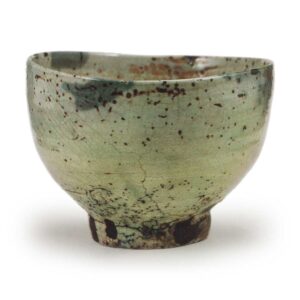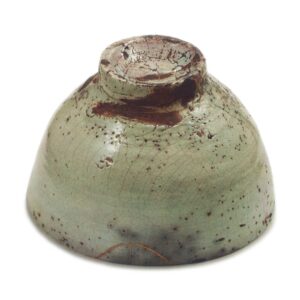

Height: 9.4-10.3cm
Diameter: 12.8-15.0cm
Outer diameter of foot ring: 6.1cm
Height of foot ring: 1.6cm
While most katte-chawan are generally mediocre, this tea bowl, which was a favorite of Oda Urakusai, is a rare gem that is both bold and full of variety.
The clay body is covered with glaze, even the foot ring is covered with glaze, so it is difficult to see the clay body, but it is close to porcelain, and it is covered with a pale sky blue glaze with a hint of blue. The thin ink-black stains that appear here and there, like raindrops, give the tea bowl a unique appearance, as do the diagonal cracks and needle-like bubbles that are characteristic of Katsute ware.
The shape of the mouth, which is distorted into an oval shape, is also one of the distinctive features of this teacup, breaking the monotony of the bold, relaxed, and unhurried shape. The firing was somewhat reductive, and the whole piece has a light blue-gray color, with a slightly light yellow tinge from the body to the waist. The name Wakana is probably derived from this. The inside of the foot ring has turned a light purple due to neutral flames, and it is impossible not to be drawn in by this color. The appeal of the Goryeo tea bowls, which replaced celadon and tenmoku, may have been in the complex and diverse changes in color. The interior is deep, and the whorl marks of the potter’s wheel, the small scooped-out indentations in the center, and the scattered light-ink-colored raindrops and cracks add variety to the interior view. The foot ring is a single, thin foot ring. It is large and solid, and the inside is shaped like a Japanese plum skin. Judging from the way it was made, it is thought that the Waridai tea bowl in the famous Hatakeyama Memorial Museum was probably made around the same time and in the same place.
There is one spot where the rim has been repaired with gold, and there are also four other spots where the lacquer has been used to cover up loose threads.
It was owned by Oda Urakusai, who greatly prized this tea bowl. After Urakusai’s death, it was kept at Kenninji Shoden-in, where he had retired, and later, for some reason, it came into the possession of Takekoshi Hozuki of Bishu. After the Meiji Restoration, it was passed from the Takekoshi family to Shibuya Sessai, who then sold it to Suganuma Kaoru for 100 yen, and in 1886 it was passed from the Suganuma family to the Ito family. A letter from Suganuma describing the process is included.
The note on the inside of the lid is by Oda Uraku, and there is a seal of Kenninji Shoden-in on the side of the box. This is a famous bowl that has not been well known until now, and it is a valuable item that is also interesting from a historical perspective, considering the relationship between Urakusai and Nagoya, and Uraku and Kenninji Shoden-in.
The following is a note written by Mr. Takekoshi on the paper covering the inner box lid.
Wakana Kente tea bowl
This tea bowl was owned by Oda Uraku Nagamasa
and he loved it very much.
There are also traces of Uraku’s handwriting on it.
After Uraku’s death, it was kept at Kenninji’s Shoden-in
. The seal of the owner is on the side of the box, so
it is a treasured item.
Hougetsu, seal



